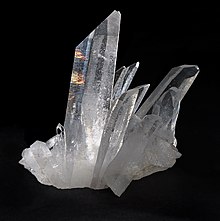al-'Aziz rock crystal ewer
The al-Aziz rock crystal ewer is a
rock crystal, standing at approximately 18 centimeters tall with a circular base 12.5 centimeters in diameter. The vessel is pear-like in shape, featuring a wide spout with a narrow neck facilitated by two moldings just above its inscription. Affixed to the ewer is a narrow handle carved from the same piece of rock crystal as the ewer body that extends from the neck down to nearly its base. A figurine of an ibex is affixed to the top of the handle. Below the bottom molding of the ewer is a footring made of gold and enamel, which along with the gold inlaid to the handle, was added in a European workshop that can be dated to the 16th century. The ewer’s body is made of thin walls adorned with unique engravings, the focus of which is a palmette motif whose axis of symmetry aligns with the spout of the ewer. This winding foliate motif extends from the top to the bottom of the ewer, as well as the handle. Flanking either side of the central foliate carvings are engravings of lions, each distinguished by individually carved dots and seated to face the central foliage on the ewer.[2]
Inscription
The al-’Aziz ewer features an Arabic inscription on its body, at the base of the vessel's neck. The inscription reads: “blessing from Allah for the imam
Fatimid period, but more precisely to the rule of al-'Aziz Bi'llah (365/975 to 386/996), or what was more likely his successor, al-Hakim bi-Amr Allah (386/996 to 411/1021), as the inscription speaks posthumously to al-’Aziz’s memory. The al-’Aziz ewer is amongst only a couple of other rock crystal objects that can help attribute the craftsmanship of these ewers to Fatimid workshops in Cairo.[1]
Materials and production techniques

Rock crystal is a notoriously difficult material to carve, as it is situated at a hardness of 7 on the
Mohs Scale, requiring a great deal of carefulness and precision for artisans to carve effectively. The al-'Aziz rock crystal Ewer is attributed to c. 1000 Fatimid Egypt like its partner vessels of the “Magnificent Seven,” and were manufactured following similar production techniques.[4] Particular information concerning the manufacturing process of rock crystal vessels such as the al-'Aziz ewer are scarce and can typically be traced to references in medieval Arabic texts written by al-Biruni and al-Tifashi. Fatimid rock crystal vessels were shaped from a single block of rock crystal using steel handheld and rotary tools.[5] Artisans would use steel saws in combination with water and abrasive to create friction and shape raw material into the form of a ewer. It is also speculated that the lathe and attachments such as grinding wheels, cutting discs, and drills were used to shape the object and carve out its interior.[5]
History and function
The al-'Aziz rock crystal ewer would likely have been used by Fatimid elites to store and dispense beverages.Pitti Palace in Florence was accidentally destroyed by a museum employee in 1998.[4]
References
- ^ ISBN 978-0300215281.
- ISBN 9780300135428.
- ^ Fein, Ariel (23 May 2023). "Rock crystal ewer, San Marco". Smarthistory. Retrieved 16 November 2023.
- ^ a b c "Fatimid Rock Crystal Ewers, Most Valuable Objects in Islamic Art". Simerg - Insights from Around the World. 2009-05-21. Retrieved 2023-12-06.
- ^ ISSN 0043-1648.
- ^ Shalem, Avinoam (1994). "Fountains of Light: The Meaning of Medieval Islamic Rock Crystal Lamps". Muqarnas. 11: 1–11.
- ISBN 9783786128434.
This article needs additional or more specific categories. (December 2023) |
